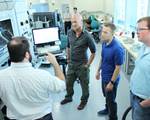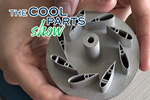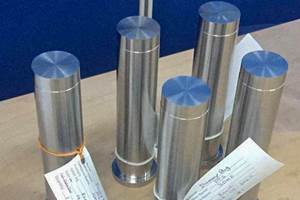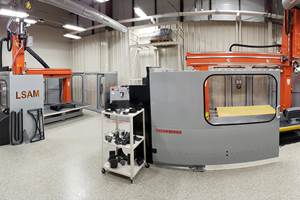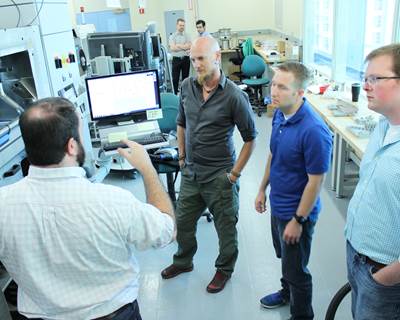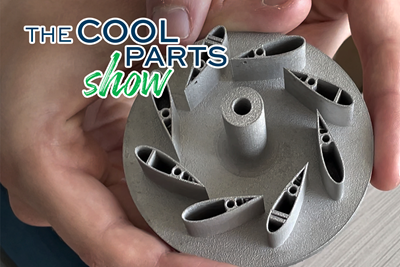The Penn State Center for Gas Turbine Research, Education, and Outreach (GTREO) is part of the same university that also hosts the Center for Innovative Materials Processing through Direct Digital Deposition (CIMP-3D). And the simple fact of this co-location on the same campus might prove to have a notable influence on the power efficiency of gas turbines in the future. CIMP-3D is The Pennsylvania State University’s engineering research organization and facility devoted to additive manufacturing, particularly in metal. GTREO director Dr. Jacqueline O’Connor turned to this group to apply laser powder bed fusion toward the redesign of a specific turbine component: the swirler.
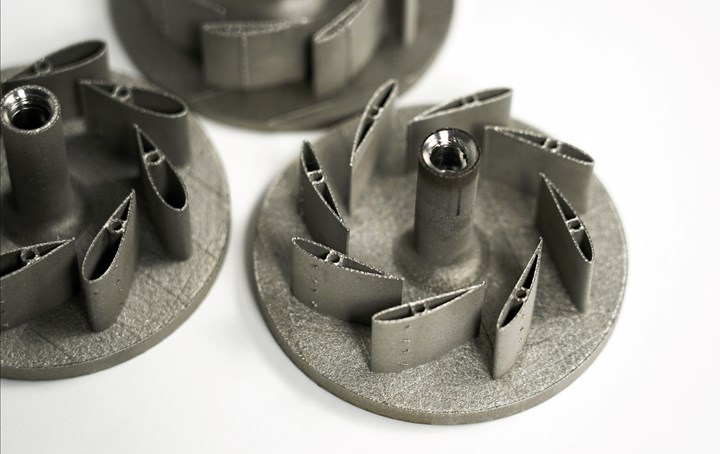
In a gas turbine, the swirler serves to feed, shape and contain the flame. In their evaluation of 3D printed swirlers, researchers modified details including the blade form and surface geometry.
The swirler is arguably an underappreciated part of a gas turbine. For those at least somewhat familiar with gas turbine operation, the picture generally goes this far: Hot gas in the turbine generates power as its pressure on blades causes a shaft to spin. But the swirler is a vital component that comes just ahead of this action, and it does a lot. This one piece of hardware mixes air and fuel, introduces turbulence and swirl to the mix, and in this way holds the flame in place that keeps the turbine gas hot.
Problem: The swirler does so much at once that geometry optimization is a difficult problem. To explore the effect of geometry changes, there would need to be a way to make and test many different designs to see what effects design changes have on various parameters of swirler performance. Until now, there has not been an easy way to manufacturer many variations on the design of this complex and expensive component. Until, that is, the arrival of additive manufacturing. The intricate components, conventionally made through precision assembly, can now be 3D printed in one piece — and to geometric forms the assembled versions could not realize. Dr. O’Connor recently turned to Penn State additive manufacturing instructor Dr. Guha Manogharan, and students he teaches in Penn State’s master’s program in additive manufacturing, instructing these students in the basics of swirler function and design. She invited them to engineer their own swirler geometries so that GTREO researchers could begin to develop a record of the performance variations associated with different sets of swirler characteristics.

“Additive manufacturing opens up the design space for this one component that’s trying to satisfy a huge number of constraints,” says Dr. Jacqueline O’Connor, a leader in gas turbine research at Penn State.
“In swirler design, you are trying to co-optimize a whole bunch of stuff at the same time,” says Dr. O’Connor in a recent episode of The Cool Parts Show devoted to this work. “You're trying to co-optimize your fuel and air mixing, and your flame stabilization, but you're also trying to optimize things like emissions performance. You're trying to optimize for acoustics, too … and then, there’s an entire structure around this part, so you're also trying to optimize for heat transfer and durability. That’s really where additive manufacturing can make a huge impact: It opens up the design space for this one component that’s trying to satisfy a huge number of constraints.”
Turbulence in the fuel-air flow is particularly meaningful for turbine performance, she says, and she had students focus on this outcome. A turbine burning a lot of fuel will generate a lot of power, while a turbine starved for fuel will generate low emissions. Both outcomes are good — is there a compromise? Potentially yes: Turbulence that optimizes combustion can strike a balance between high power output and low environmental impact.
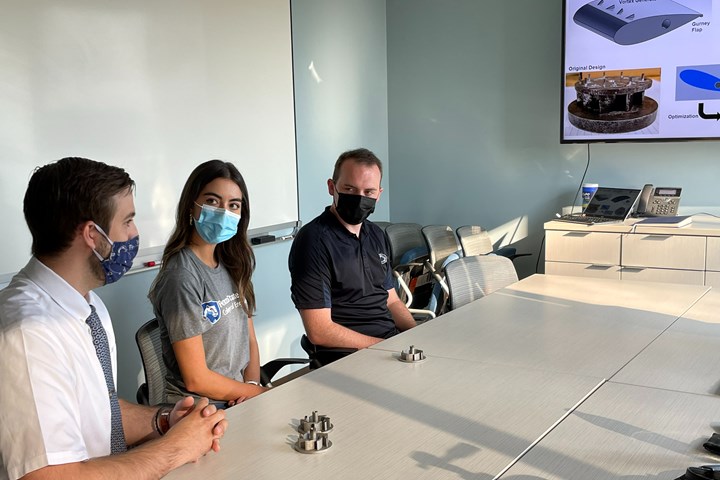
Additive manufacturing masters program students involved in the swirler work include (left to right) Lach Peeke, Paula Clares and Baily Thomas.
Student designs were 3D printed in Inconel 718 on a ProX 320 powder bed fusion system from 3D Systems, with a baseline swirler printed on a powder bed fusion machine from Xact Metal. There were constraints bounding the project: “I needed certain things to be the same,” Dr. O’Connor says. “The swirlers had to be the same size because I needed to be able to bolt them into the same [test rig]. And I needed the same number of blades on each because there are certain patterns in the flow that are generated by the blades and I wanted to make sure I wasn’t losing those. And then we had some constraints on the open area. I wanted to make sure that we weren’t closing things down too much. That would change the pressure drop through the system, and it could also dramatically change the acoustics.” Given all that, however, the surface detail remained unconstrained. In addition to changing the shapes of airfoil blades, the students worked with the airfoil surface in their pursuit of turbulence. They turned to biomimicry.
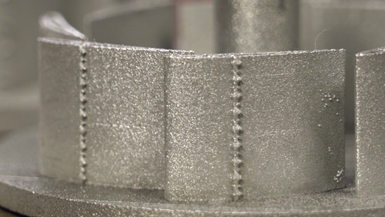
As a potential aid to turbulence that would be beneficial to fuel efficiency, researchers borrowed the shape of structures on shark scales that provide a similar turbulence-inducing effect.
“We asked, what if we were to add additional features on the outside?” says Paula Clares, one of the Penn State AM students involved in the swirler work. “We found this research from Cambridge University in which they talk about the hydrodynamics of adding shark-fin structures to parts.” The surface detail of shark scales enhances turbulence. The students used shark scale models obtained via scanning electron microscope and added these to the surfaces of swirler blades, in search of the same beneficial effect.
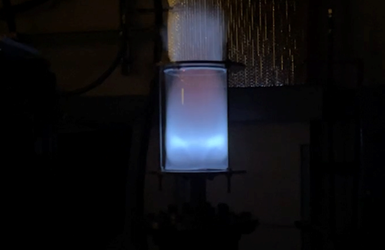
Next step is evaluating the swirlers by measuring the flame they produce on a test platform at Penn State.
Are shark scales the performance-enhancing vital feature that has long been missing from gas turbines? Perhaps yes. More likely, of course, it’s not that simple. At this writing, the physical evaluation of the 3D printed swirlers using the flame test stand within the GTREO Reacting Flow Dynamics Laboratory has not yet been performed. The work is just beginning. Yet just the creation of these novel swirler forms, using surface features not previously practical to attain, represents an important advance — and a hint at what is coming for turbine engineering. Swirlers have been a component essentially too complex to optimize. Interrelated features contribute to interrelated performance outcomes, and exploration of new design has been limited to what designs could be produced. Now, with AM potentially providing a relatively low-cost method to iterate swirler designs and produce them rapidly, the way is clear to discovering just how much the swirler geometry can contribute to what a gas turbine can do.
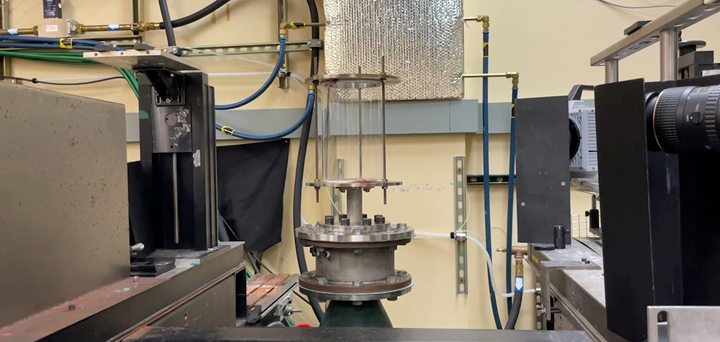
Here is that same test platform (previous photo) sans flame.
3D Printing for Better Flame From a Gas Turbine Swirler: The Cool Parts Show #42
Hear more from gas turbine researcher Dr. Jacqueline O’Connor and the additive manufacturing students at Penn State on this episode of The Cool Parts Show about swirler designs made possible through additive manufacturing. WATCH
Related Content
Video: 5" Diameter Navy Artillery Rounds Made Through Robot Directed Energy Deposition (DED) Instead of Forging
Big Metal Additive conceives additive manufacturing production factory making hundreds of Navy projectile housings per day.
Read MoreConocoPhillips Sees Oil and Gas Supply Chain Opportunity With Additive Manufacturing
Production of parts when needed and where needed can respond to the oil and gas sector’s multibillion-dollar challenge of holding parts in inventory. The supply chain benefit will justify additive even before the design freedoms are explored.
Read MoreDOE Awards Nearly $3 Million to Develop Additive Manufacturing of Modular Wind Blades
The industry partners received the award to develop automation in additive manufacturing of tooling for large-scale wind blades that can accommodate continuous changes in blade geometry and scale.
Read MoreBPMI Chooses Velo3D Metal 3D Printing System to Produce Parts for U.S. Naval Nuclear Propulsion Program
The fully integrated 3D printing solution will be operated by ATI in a newly established facility that will provide the U.S. Naval Nuclear Propulsion Program with alternatives to cast parts.
Read MoreRead Next
Inside the Penn State Additive Manufacturing Master’s Program, Part 1
PSU's engineering master's degree in additive manufacturing and design offers students and manufacturing professionals a higher education in a continuously maturing field.
Read More3D Printing for Better Flame From a Gas Turbine Swirler: The Cool Parts Show #42
A Penn State gas turbine researcher turns to additive manufacturing graduate students to help face the challenge of swirler optimization.
Read MorePrototyping Is More Than Printing: The Cool Parts Show Bonus
We hear from students who carried out other steps, beyond the 3D printing, that went into evaluating a complex metal AM component.
Read More


